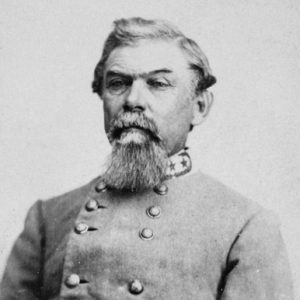calsfoundation@cals.org
Third Arkansas Light Artillery (CS)
aka: Jackson Light Artillery
The Third Arkansas Light Artillery was a Confederate unit that served in the Western Theater in a variety of roles throughout the Civil War.
The battery that would come to be known as the Third Arkansas was organized at Jacksonport (Jackson County) on June 15, 1861, under the command of Captain George McCown. The unit was known as McCown’s Battery during its early existence. The battery joined two other Arkansas artillery units in a battalion under the command of Major Francis Shoup, and this unit transferred to Confederate service on July 25, 1861. McCown resigned his commission on July 17, and Second Lieutenant George Hubbard was elected to lead the battery.
The battalion moved to the east bank of the Mississippi River in late 1861 and served in Major General William Hardee’s division in Kentucky and Tennessee. The battalion retreated into Mississippi after the capture of Forts Henry and Donelson in February 1862. Participating in the Battle of Shiloh in April, the battery was part of a large concentration of artillery that helped overcome Union forces holding the so-called Hornet’s Nest.
After the Confederate defeat and retreat to Corinth, James Thrall became captain of the battery on May 12, 1862, a position he held until the end of the war. The battery evolved into a heavy artillery unit in the summer of 1862. Stationed at Columbus, Mississippi, the battery had one thirty-two-pound siege gun, one three-inch rifle, and one six-pound gun. The battery was also armed with a number of rifles and other equipment, serving under Brigadier General Daniel Ruggles, commander of the First Military District of the Department of East Louisiana and Mississippi. By the summer of 1863, efforts were under way to reequip the battery as a light artillery unit. This was done by January 1864, when the battery is listed as being armed with four six-pound bronze guns and two other six-pound guns. The battery continued to serve under Ruggles in the cavalry corps under the command of Major General Stephen Lee.
Also serving under Major General Nathan Bedford Forrest, the battery saw action in Mississippi in early 1864. Part of the unit also fought in an action along the Yazoo River in March 1864. After a reorganization of Forrest’s cavalry corps, the battery joined three others in Brigadier General Abraham Buford’s division. These four batteries were formed into a battalion under the command of Captain John Morton. Participating in several campaigns across Mississippi, Tennessee, and Alabama, the battery saw action at the Battle of Johnsonville, among others.
In November 1864, Forrest moved his cavalry corps to join the Army of Tennessee in an effort to capture Nashville. Thrall’s battery did not accompany Forrest and moved to Corinth, Mississippi, where it manned fortifications protecting the town. The battery came under the command of Brigadier General George Hodge in the District of Southwest Mississippi and East Louisiana. The battery moved to Mobile, Alabama, where it joined the defenses around the city. Seeing action at the Battle of Spanish Fort in March and April 1865, the battery retreated into the city. With few options, the Confederate forces declared Mobile to be an open city and continued to retreat in the face of Federal pursuers.
The battery surrendered at Meridian, Mississippi, on May 11, 1865.
For additional information:
Daniels, Larry. Cannoneers in Gray: The Field Artillery of the Army of Tennessee, 1861–1865. Tuscaloosa: University of Alabama Press, 2005.
Morton, John Watson. The Artillery of Nathan Bedford Forrest’s Cavalry: “The Wizard of the Saddle.” Nashville, TN: Publishing house of the M.E. church, South, Smith & Lamar, Agents, 1909. Online at https://archive.org/details/artillerynathan00mortgoog (accessed June 25, 2021).
David Sesser
Henderson State University
 Civil War Timeline
Civil War Timeline Military
Military ACWSC Logo
ACWSC Logo  William J. Hardee
William J. Hardee 




Comments
No comments on this entry yet.